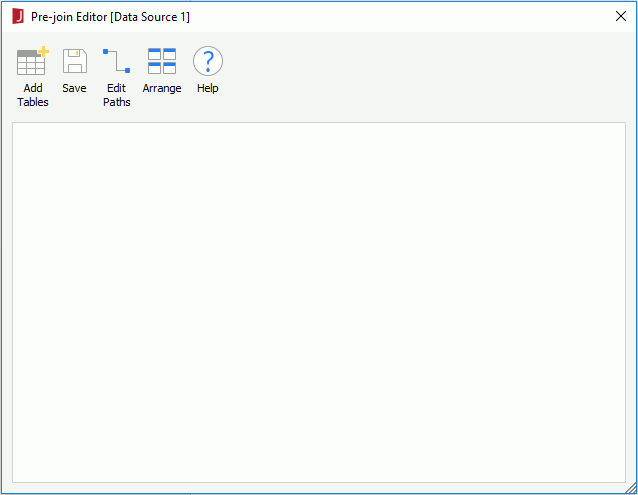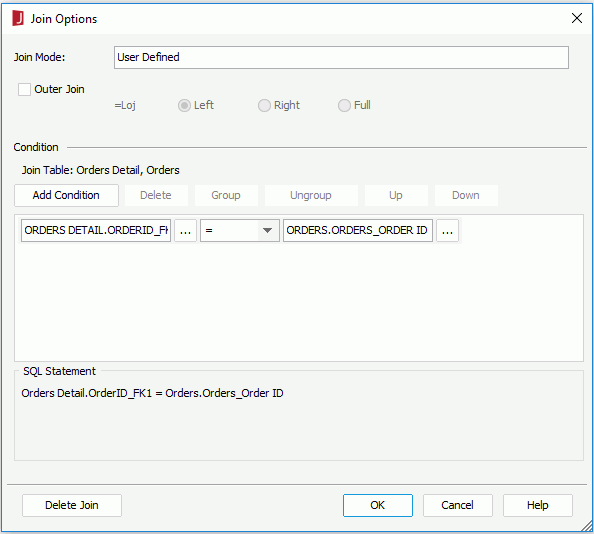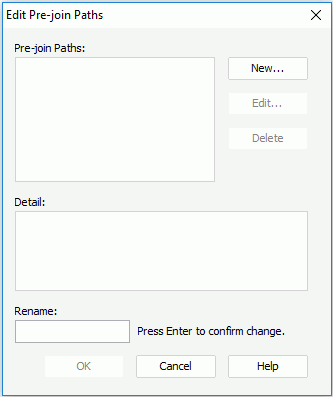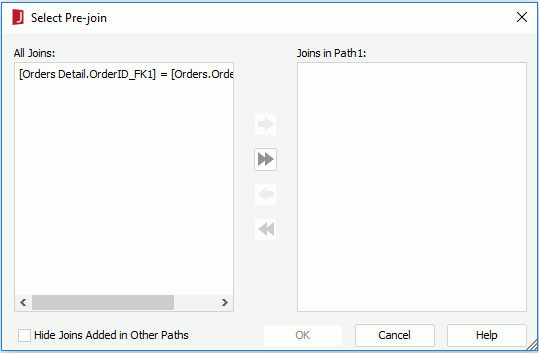 Previous Page Next Page
Previous Page Next Page
After data resources such as tables, views, synonyms, queries, imported SQLs, stored procedures, and user defined data sources have been added to a catalog, you can now use them to build reports. However, in your daily work, you may often be dealing with a set of data resources in your queries. You will have to define relationships and create joins among different data resources every time you create a new report.
JReport Designer provides you with the pre-join feature which can be used for creating/editing queries. You can create distributed pre-joins between the data resources that are mashed up from different connections in a catalog. The pre-join information is one type of resource that is not stored in the catalog. It is saved in a standalone file with the extension .pre, and shares the same prefix as the catalog file. It is not used at report runtime. In JReport Designer, when you open a catalog, the pre-join file is opened at the same time. When you save the catalog, the pre-join file is also saved. Once you create a .pre in a folder, you can copy the .pre file to any other folders that use the same catalog.
The Pre-join Editor is a convenient tool for you to predefine the relationships between data resources all at once in a catalog.
The Pre-join Editor appears.

When the selected catalog data source contains XML connections, tables from the XML connections will be automatically added in the Pre-join Editor, and when the Generate the default pre-join path option is checked for the XML connections, if the parent and children nodes are transformed to different tables in an XML connection, joins will be embodied by the parent-child relationship by default, which is maintained by primary key and foreign key in the tables.
Point to one column in the source table, press and hold the mouse button, then move the pointer to the other column in the target table and release the mouse button. A green line with a join icon  will be shown, linking the two columns. This represents that a join has been created.
will be shown, linking the two columns. This represents that a join has been created.
 . The Join Options dialog appears.
. The Join Options dialog appears.

Click  beside the two text boxes to select a column in the two tables involved in the join, or a parameter or constant level formula in the current catalog data source and select the operator to compose the condition. You can also manually input the column, parameter or formula name in the text boxes (parameters and formulas should be input in the format @ParameterName or :ParameterName.). When a parameter is referenced in a join condition, the Ignore Predicate If Parameter Value Is Null setting of the parameter will be ignored.
beside the two text boxes to select a column in the two tables involved in the join, or a parameter or constant level formula in the current catalog data source and select the operator to compose the condition. You can also manually input the column, parameter or formula name in the text boxes (parameters and formulas should be input in the format @ParameterName or :ParameterName.). When a parameter is referenced in a join condition, the Ignore Predicate If Parameter Value Is Null setting of the parameter will be ignored.
To add another condition line, click the Add Condition button and define the condition as required. Then from the logic drop-down list, specify the relationship between the two condition lines. Repeat this to add more condition lines if necessary.
To make some conditions grouped, select them and click the Group button, then the selected conditions will be added in one group and work as one line of conditional expression. Conditions and groups together can be further grouped.
To take any condition or group in a group out, select it and click Ungroup.
To adjust the priority of the conditions, select it and click the Up or Down button.
To delete a condition line, select it and click the Delete button.
 and then click the Delete Join button in the Join Options dialog.
and then click the Delete Join button in the Join Options dialog. With conventional joins, records that do not satisfy the join condition are eliminated from the result. An outer join preserves these records in the result and replaces the missing values with nulls. SQL syntax uses the left outer join if the records in the left side table are preserved and right outer join if the records on the right side table are preserved. The left side is determined by where the arrow begins and the right side is determined by the side the arrow points to. It is independent of the location of the table in the Pre-join Editor or Query Editor. When you drag to make the join, you always drag logically from left to right even if your view in the query editor is right to left.
For example, consider the following two tables where the join arrow points from the Customer.C# to the Order.C#:
Table 1:
| Order | O# | C# |
|---|---|---|
| 101 | 001 | |
| 102 | 002 | |
| 103 | 004 |
Table 2:
| Customer | C# | Name |
|---|---|---|
| 001 | GE | |
| 002 | IBM | |
| 003 | DELL |
The inner join of Customer.C# = Order.C# will produce the following result:
| Join Result | O# | Customer.C# | Name |
|---|---|---|---|
| 101 | 001 | GE | |
| 102 | 002 | IBM |
The left outer join on Customer.C# = Order.C# will produce the following result:
| Join Result | O# | Customer.C# | Name |
|---|---|---|---|
| 101 | 001 | GE | |
| 102 | 002 | IBM | |
| <null> | 003 | DELL |
The right outer join on Customer.C# = Order.C# will produce the following result:
| Join Result | O# | Order.C# | Name |
|---|---|---|---|
| 101 | 001 | GE | |
| 102 | 002 | IBM | |
| 103 | 004 | <null> |
The full outer join on customer.C# = order.C# will produce the following result:
| Join Result | O# | Order.C# | Customer.C# | Name |
|---|---|---|---|---|
| 101 | 001 | 001 | GE | |
| 102 | 002 | 002 | IBM | |
| <null> | <null> | 003 | DELL | |
| 103 | 004 | <null> | <null> |
After you have created joins between the tables in the Pre-join Editor, you can then use them to define paths. To do this:


 to add them to the right box, then click OK to dismiss the dialog and return to the Edit Pre-join Paths dialog. The joins included in the path will be displayed in the Detail box.
to add them to the right box, then click OK to dismiss the dialog and return to the Edit Pre-join Paths dialog. The joins included in the path will be displayed in the Detail box.To edit or delete a path, select it in the Pre-join Paths box, then click the Edit or Delete button.
To rename a path, select it in the Pre-join Paths box, then in the Rename box, type the new name and then press Enter to confirm.
You must define at least one path for the joins you create. If no path is defined, when you click Save on the Pre-join Editor toolbar:
You can save the relationships by clicking Save on the Pre-join Editor toolbar. Note that the pre-join information won't really be saved to disk until you save the catalog. After you have saved the catalog, you can then use the just created pre-join to develop reports.
Notes: